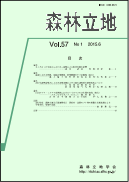Volume 35, Issue 1
Displaying 1-9 of 9 articles from this issue
- |<
- <
- 1
- >
- >|
-
Article type: Article
1993Volume 35Issue 1 Pages 3-8
Published: June 30, 1993
Released on J-STAGE: April 03, 2017
Download PDF (667K) -
Article type: Article
1993Volume 35Issue 1 Pages 9-14
Published: June 30, 1993
Released on J-STAGE: April 03, 2017
Download PDF (735K) -
Article type: Comment
1993Volume 35Issue 1 Pages 15-21
Published: June 30, 1993
Released on J-STAGE: April 03, 2017
Download PDF (730K) -
Article type: Article
1993Volume 35Issue 1 Pages 22-29
Published: June 30, 1993
Released on J-STAGE: April 03, 2017
Download PDF (806K) -
Article type: Record
1993Volume 35Issue 1 Pages 30-31
Published: June 30, 1993
Released on J-STAGE: April 03, 2017
Download PDF (347K) -
Article type: Article
1993Volume 35Issue 1 Pages 32-41
Published: June 30, 1993
Released on J-STAGE: April 03, 2017
Download PDF (1121K) -
Article type: Article
1993Volume 35Issue 1 Pages 42-49
Published: June 30, 1993
Released on J-STAGE: April 03, 2017
Download PDF (1320K) -
Article type: Comment
1993Volume 35Issue 1 Pages 50-59
Published: June 30, 1993
Released on J-STAGE: April 03, 2017
Download PDF (964K) -
Article type: Document
1993Volume 35Issue 1 Pages 60-65
Published: June 30, 1993
Released on J-STAGE: April 03, 2017
Download PDF (418K)
- |<
- <
- 1
- >
- >|
